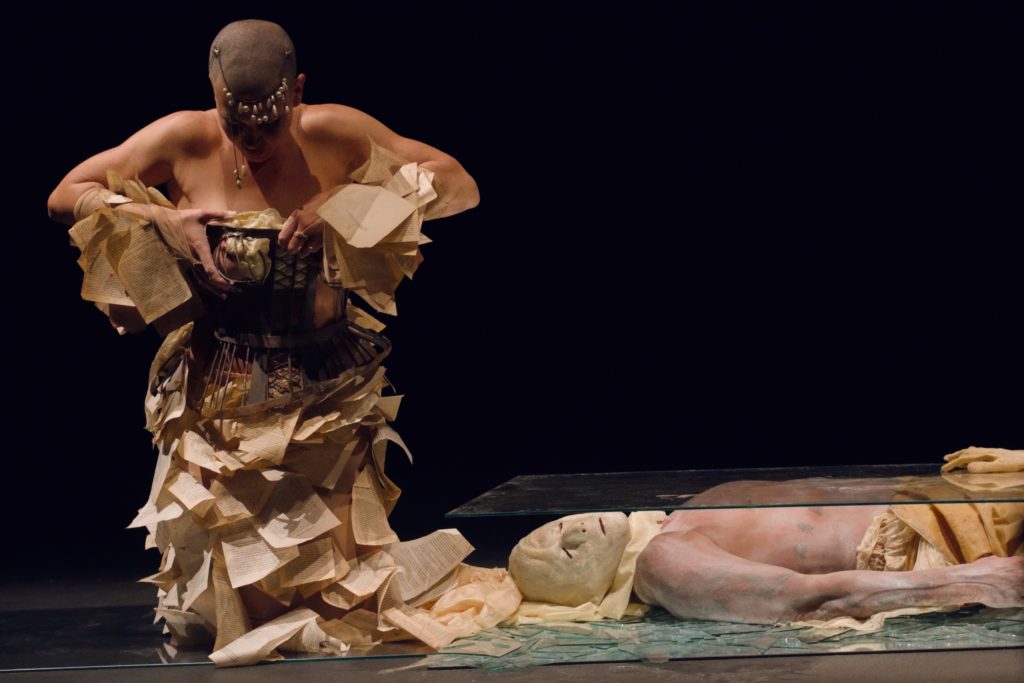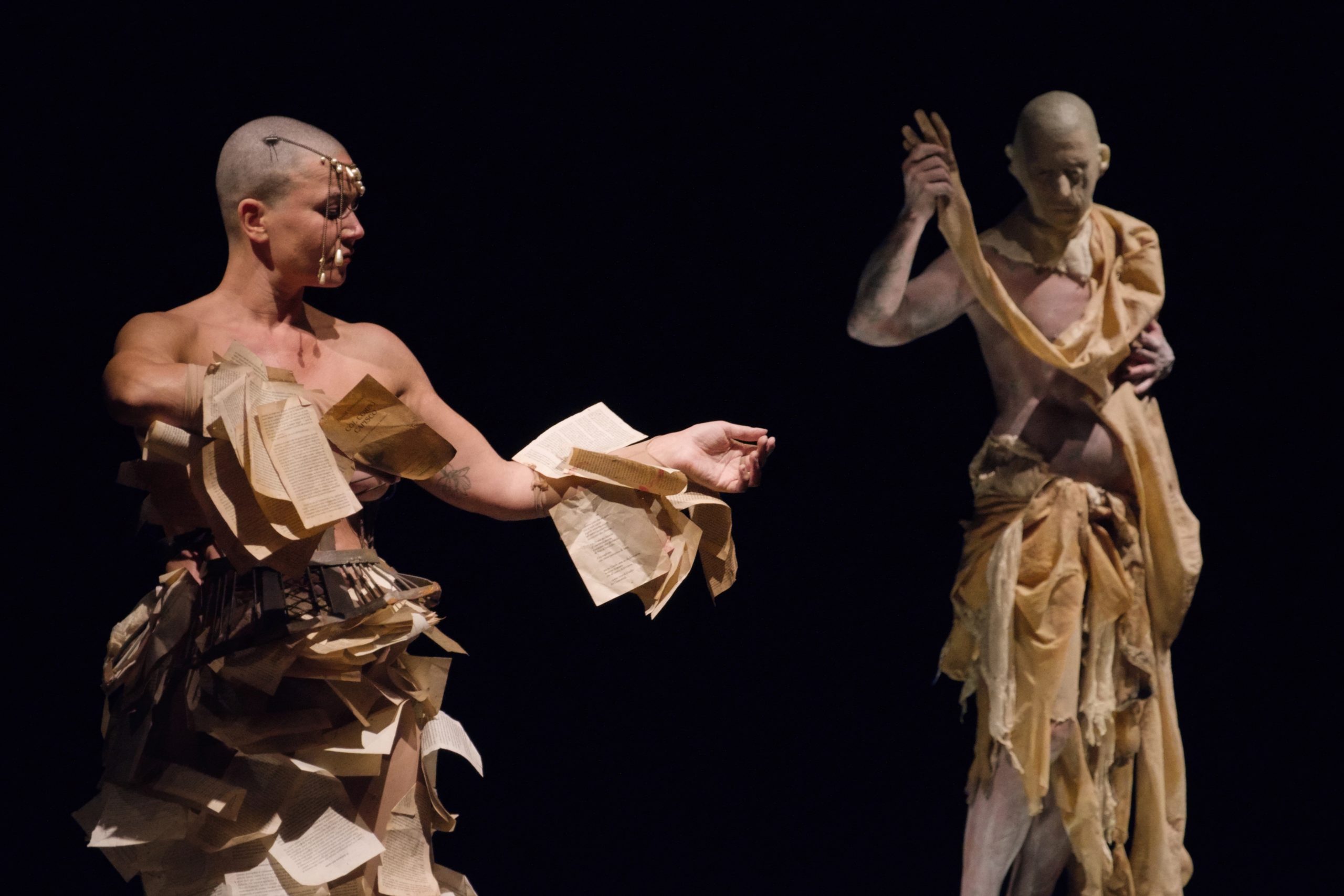Words by Bengi-Sue Sirin.
Tuberculosis is something I know very little about. It feels very far away – either as part of the Romantic poet era or as something nobody I know has had. But a daring and quite unique piece of dance-cum-performance art I saw at The Place opened my eyes to a new way of looking at TB (even if at times I squeamishly covered said eyes with my fingers!)
1 9 Monologue, specifically not nineteen but ‘one nine,’ was performed by Verena Stenke (German) and her husband Andrea Pagnes (Italian). Together they are VestandPage, a ground-breaking and prolific performance art company known for their philosophical themes and defiance of convention.
Do not be surprised to see blood in a VestandPage piece! Their creative process is thorough and multifaceted. I wasn’t sure what ‘1 9’ signified, but I got some clarity at the post-show talk. Stenke explained ‘1 and 9, two parts talking to one another… 1 is the self, shown by me, and 9 is an other, the bacteria multiplying, performed by Andrea.’ And the monologue aspect was pretty self-explanatory; a poetic composition detailing TB, referencing the vast history of the disease, the reams of people who ‘died so that [we] can live,’ and the science behind it. I especially remember from the beginning, “When we open our mouths, we can’t be responsible for everything that goes in.” Then Stenke screamed silently into a yellowed bookpage, and we were sucked into the world of TB, a world she herself was temporarily a part of.
“It was the Danse Macabre but with latex.”
To her side, across a walkway made of shattered glass, was Pagnes. He kneeled on the floor, wrapped in knotted bandages that reminded me of sinews and tendons and Egon Schiele paintings. A sort of flesh-coloured latex mask bound his head and his bicep was pierced by feathers. He did look as ‘bacterial’ as a human can get. Pagnes bound his ankles in knots of barbed wire and blew into a bowl of incense-like ash, sending smoky white whorls into the air. Such movements were strikingly corporeal reminders of the constant proximity of airborne infectious diseases like TB, and the unrelenting grasp they trap us in. Then, he picked up what I realised was a deflated inflatable cast, and began to slowly waltz with it to a Weimar-esque tinkling piano tune. It was the Danse Macabre but with latex. I found the way that he held it upright, his hand jerked into its ruptured head, to draw attention to the sallowness of sickness and not far off skeletal.
The next section took corporeality to the next level, though. That shattered glass walkway became a hellish runway under Pagnes’ bare feet, which he painstakingly made his way across whilst supporting an intact (and very heavy-looking!) glass pane on his back. I was sitting within three metres and I heard every crunch, amplified through the microphones of my hearing aids, lucky me! A particularly big one made us all wince, even the deaf friends I was with (trust me when I say the crunching of glass is just as visual as it is auditory). I covered my eyes when I saw a jagged shard stubbornly stuck in his heel. The sheer destructive possibilities of this glass-walking motif was on the verge of too much, but made a very important point about TB and how we mustn’t overlook it. It still impacts more than 1.5 million people worldwide a year, a fact I learned from the program notes. The differences between the two bodies of glass drew attention to how something intact and something broken are actually two sides of the same thing, how easily we turn a blind eye to multiplicity, and how close we are to fragmentation at any moment.
Once he finished his harrowing crossing over the shattered glass, Pagnes reached Stenke. She stood encased in a torturous looking metal corset, half majestic and half subjugated. Bare skin was patched over with more of that yellowed paper. The intact glass pane was placed between the two performers, allowing the disease to stare the afflicted right in the face. Pagnes blew a puff of that white ash towards Stenke, who was protected only by that sheet of glass. The remnants of that latex body cast were draped over the top of the pane and tugged by each in a show of fragility. It was as though we watched the moment the TB seeped its way into Stenke’s body, rendering her infected. We saw her sheer will to resist while in so much pain, to simply not shatter. I was transfixed.

Another very moving sequence was Pagnes crawling across the shattered glass, eventually lying down on his back. I saw thin red ribbons of blood on stray latex. Then, Stenke used the intact pane to impose a sort of whole body mammogram on him, crushing him beneath it. It was an interesting twist of agency whereby the afflicted became the observer, looking down at him like a specimen or an exhibit. After a bacteria-dominated first section, it was refreshing to see Stenke lead the movements. And for the first time, I felt hope. That TB, portrayed thus far as all powerful and glass-walkingly fearless, may be contained or even cured. Which it can! And 1 9 Monologue didn’t end here, it took an even more positive bow out. Randomly chosen members of the audience were invited up to respond to a mysterious question asked by Pagnes into a looping microphone. These utterances layered on top of one another far quicker than I could comprehend – I only caught the word ‘hope.’ However, I liked the symbolism of audience participation as an erosion of the stigma towards TB. I think all of us underwent a complete shift in our attitude towards it, which is really a remarkable thing for a 70 minute performance art piece to accomplish. Bravo!
Another bravo for the wonderful BSL interpreter too, Sumayya Si-Tayeb. I saw ‘BSL interpreted’ on the program but didn’t know what level of involvement to expect. Si-Tayeb, who I had the chance to chat to afterwards, was asked by VestandPage to do what is called ‘free translation,’ which is less word-for-word than poetic interpretation of the text. The way she moved had lots in common with dance itself, and also with what is known in the deaf community as Visual Vernacular (well worth checking out if you are unfamiliar!) I cannot express enough how magnetic Si-Tayeb’s performance was, but at the same time I do wonder if something more in line with direct translation would have provided more clarity for the deaf friends I sat with. Either way, hers was a facet of the piece that I turned to for respite from the intense glass-crunching!
The post-show talk added another facet that makes me reflect on 1 9 Monologue with fondness. As I mentioned briefly, Stenke herself had TB and it is clear how personal the piece is by how deeply they dig into pain. She spoke articulately about the difficulties of her TB coinciding with COVID, about her process and its catharsis, her inspirations… But it is what Pagnes said that really struck me. He described 1 9 Monologue as ‘a kind of love story… a focus on my wife.’ I truly saw that in their movement catalogue, from the extremely delicate way they handled the intact glass pane, to his self-flagellating interaction with the shattered one. As Stenke said, “when you are sick you are fighting and fighting, trying to find a way out,” and I think 1 9 Monologue really captured that. Yes it was a tough watch, but it had something very important to show us.
